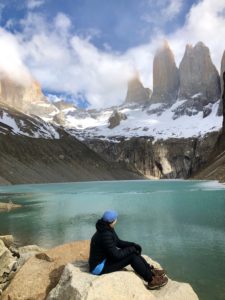Chile’s Beauty
Right outside my apartment window sits
Cerro Santa Lucía, a beautiful European-style urban park in the heart of Santiago. If I walk anywhere in the city, I am bound to pass a park, whether it be Chile’s largest urban park (and the third-largest in the world) –
Parque Metropolitano – or the picturesque picnic spot and paddleboat location of
Parque Quinta Normal. Beyond the crowded areas of the city, the outskirts of Santiago offer numerous hiking trails that can be done in a few hours. Cerro Pochoco, Cerro Manquehue (or the easier option of Manquehuito), and Aguas Ramón (my personal favorite) are easy to locate, making them perfect for a morning hike and afternoon lunch on the top of the Cerros.

Going beyond Santiago’s borders, Chile is a nature haven. Just 40 minutes outside the city is
Cajón Del Maipo, home to a diverse range of Andean birds, including the Condor. You can hike Mirador De Los Cóndores, or find the thermal springs. A few hours outside the city is
La Campana National Park, where Charles Darwin hiked on his second voyage on the HMS Beagle. Depending on when you come to Santiago, IFSA will also take you on a trip to the
Atacama Desert, one of the driest places in the world. In my opinion, the nature-gem of Chile is Patagonia, located in the south of the country. A three-hour flight brings you to one of the most beautiful natural parks in the world
Torres Del Paine in Puerto Natales. Here you can see glaciers, guanacos, condors, the horn-shaped peaks of Cuernos del Paine, and bright blue lakes. Also, the oldest national park–
Vincente Pérez National Park – is found in Patagonia, located in the rainforests of Andes Australes, near Puerto Varas.

Environmental Problems : Air pollution
While Chile is home to such beautiful environmental hubs, it is no stranger to the impact of the human footprint. Torres Del Paine is still recovering, even years later, from a
tourist-caused forest fire in 2011 that destroyed over 16,000 hectares of the park. If you visit, you can still see the charred remains of the natural areas, and the desperate revitalization projects underway.
Arguably Chile’s most pressing environmental problem is air pollution. Santiago is situated in natural basins surrounded by mountains, meaning that it keeps the smog and other air pollutants close to the ground. Hiking Cerro Pochocho or even climbing Cerro San Cristobal in Santiago gives you a view of the smog layer above the city. In 2011, 10 million people of the country’s 17 million population, were exposed to
fine dust particles way above the permitted limit. Long-term exposure to such particles can have severe health repercussions, including lung disease and respiratory illnesses. In Greenpeace’s
2018 World Air Quality Report, Chile had 34 of the 46 most air-polluted Latin American cities. Overall, Santiago was ranked the 394th worst city in terms of air pollution out of 3,058 cities worldwide.
Chile’s Progress: An emerging global environmental leader
While the figures are concerning, Chile is emerging as a global environmental leader. This coming December, Chile will host the 2019 United Nations Climate Change Conference (COP25). In 2014, the government launched a program to replace
200,000 firewood heaters (a leading cause of the air pollution), with more energy-efficient heaters. The government also enforces an
emissions tax in an effort to reduce its greenhouse gas emissions by 20% by 2020. Additionally, 45% of Chile’s energy comes from clean sources, and the country is aiming to make it 90% by 2050.
In 2010, the government initiated Santiago’s Cycle Route master plan to create a total of 550 km of bike paths in the urban areas, with 140 km in the rural zones.
Bike Santiago is a rental bike company with bright orange bikes parked all around the city, making it easy to avoid CO2 emissions while fitting in an exercise to your destination. You can also follow
Ciclo Recreo Via, a project that encourages families to head out on their bikes. On Sundays, many busy streets of Santiago are closed off to cars, becoming exclusively biking, running, and walking paths. Ciclo Recreo Via provides various bike circuits around the city for your convenience. There are also more touristy options, such as
La Bicicleta Verde, which offers bike tours of Santiago.
Reflections
Of course, before coming to Santiago I had an appreciation for nature. But my appreciation stemmed from living in a bustling city, where I limited my hiking on the outskirts due to the high volume of ticks. My passion for environmental issues was limited and removed. It was a passion rooted in a few hours of nature exposure – occasional vacations and hikes – all of which were overshadowed by my lifetime of city metros, traffic, and skyscrapers.

Santiago is a city, but it is a city with pockets of nature havens, and with tranquil nature escapes right outside its borders. Traveling within Chile is much easier for me than traveling within the U.S. We often travel in groups, lowering the cost of transportation; flights are more affordable domestically; my class schedule allows me more flexibility in traveling than it does at home. I have never had the opportunity to immerse myself in nature like I have here.
These new surroundings have taught me how to be more aware of my environmental footprint: I reuse everything, limit my use of plastic, follow the “leave no trace” ideology on hikes and excursions, and follow Chilean environmental policy developments. These are small steps in such a large problem, but they are steps I wasn’t fully conscious of before my arrival. I limited my plastic use because it seemed like the right thing to do, not because I was truly educated on the costs of its uses. Studying abroad in Santiago has changed that: I am now aware of what my actions and their consequences mean for the environment. I have seen what it is we are trying to protect, and that has changed my entire worldview.
Cira Mancuso is an International Affairs student at Georgetown University, and studied abroad with IFSA at the Chilean Universities Program in Santiago, Chile, in Fall 2019. She is an International Correspondent for IFSA through the Work-To-Study Program.
 Going beyond Santiago’s borders, Chile is a nature haven. Just 40 minutes outside the city is Cajón Del Maipo, home to a diverse range of Andean birds, including the Condor. You can hike Mirador De Los Cóndores, or find the thermal springs. A few hours outside the city is La Campana National Park, where Charles Darwin hiked on his second voyage on the HMS Beagle. Depending on when you come to Santiago, IFSA will also take you on a trip to the Atacama Desert, one of the driest places in the world. In my opinion, the nature-gem of Chile is Patagonia, located in the south of the country. A three-hour flight brings you to one of the most beautiful natural parks in the world Torres Del Paine in Puerto Natales. Here you can see glaciers, guanacos, condors, the horn-shaped peaks of Cuernos del Paine, and bright blue lakes. Also, the oldest national park– Vincente Pérez National Park – is found in Patagonia, located in the rainforests of Andes Australes, near Puerto Varas.
Going beyond Santiago’s borders, Chile is a nature haven. Just 40 minutes outside the city is Cajón Del Maipo, home to a diverse range of Andean birds, including the Condor. You can hike Mirador De Los Cóndores, or find the thermal springs. A few hours outside the city is La Campana National Park, where Charles Darwin hiked on his second voyage on the HMS Beagle. Depending on when you come to Santiago, IFSA will also take you on a trip to the Atacama Desert, one of the driest places in the world. In my opinion, the nature-gem of Chile is Patagonia, located in the south of the country. A three-hour flight brings you to one of the most beautiful natural parks in the world Torres Del Paine in Puerto Natales. Here you can see glaciers, guanacos, condors, the horn-shaped peaks of Cuernos del Paine, and bright blue lakes. Also, the oldest national park– Vincente Pérez National Park – is found in Patagonia, located in the rainforests of Andes Australes, near Puerto Varas.

 Santiago is a city, but it is a city with pockets of nature havens, and with tranquil nature escapes right outside its borders. Traveling within Chile is much easier for me than traveling within the U.S. We often travel in groups, lowering the cost of transportation; flights are more affordable domestically; my class schedule allows me more flexibility in traveling than it does at home. I have never had the opportunity to immerse myself in nature like I have here.
These new surroundings have taught me how to be more aware of my environmental footprint: I reuse everything, limit my use of plastic, follow the “leave no trace” ideology on hikes and excursions, and follow Chilean environmental policy developments. These are small steps in such a large problem, but they are steps I wasn’t fully conscious of before my arrival. I limited my plastic use because it seemed like the right thing to do, not because I was truly educated on the costs of its uses. Studying abroad in Santiago has changed that: I am now aware of what my actions and their consequences mean for the environment. I have seen what it is we are trying to protect, and that has changed my entire worldview.
Cira Mancuso is an International Affairs student at Georgetown University, and studied abroad with IFSA at the Chilean Universities Program in Santiago, Chile, in Fall 2019. She is an International Correspondent for IFSA through the Work-To-Study Program.
Santiago is a city, but it is a city with pockets of nature havens, and with tranquil nature escapes right outside its borders. Traveling within Chile is much easier for me than traveling within the U.S. We often travel in groups, lowering the cost of transportation; flights are more affordable domestically; my class schedule allows me more flexibility in traveling than it does at home. I have never had the opportunity to immerse myself in nature like I have here.
These new surroundings have taught me how to be more aware of my environmental footprint: I reuse everything, limit my use of plastic, follow the “leave no trace” ideology on hikes and excursions, and follow Chilean environmental policy developments. These are small steps in such a large problem, but they are steps I wasn’t fully conscious of before my arrival. I limited my plastic use because it seemed like the right thing to do, not because I was truly educated on the costs of its uses. Studying abroad in Santiago has changed that: I am now aware of what my actions and their consequences mean for the environment. I have seen what it is we are trying to protect, and that has changed my entire worldview.
Cira Mancuso is an International Affairs student at Georgetown University, and studied abroad with IFSA at the Chilean Universities Program in Santiago, Chile, in Fall 2019. She is an International Correspondent for IFSA through the Work-To-Study Program.